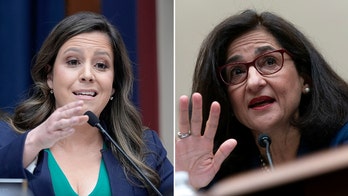US ambassador to Libya, 3 embassy staff killed in attack
Greg Palkot reports on deadly assault
The attack started with little warning. The U.S. diplomatic compound in Benghazi began taking fire at 10 p.m. Tuesday night. Within minutes, the attackers were in -- firing inside the building.
It would be hours before U.S. personnel regained control. And hours before U.S. ambassador Christopher Stevens' body was recovered.
These details and others emerged late Wednesday, as U.S. officials sought to reconstruct what happened in those chaotic and violent hours in eastern Libya the night before.
The attack on the U.S. Consulate left four dead, including Stevens, and three wounded. Questions have swirled over what instigated the attack, with a number of lawmakers and others speculating that it might have been a coordinated strike timed for the 11th anniversary of the Sept. 11 attacks. Speculation is also widespread over Stevens' exact cause of death.
Senior administration officials, in a briefing late Wednesday, could not answer those two questions. But they sought to explain how the attackers mounted such a deadly assault on the compound, and in doing so acknowledged that U.S. personnel effectively lost track of Stevens after the initial attack.
Though details could change and State Department employees are still piecing together what happened, officials described the chain of events on Tuesday night as follows:
At 10 p.m. local time (4 p.m. ET, in Washington), the compound "began taking fire from unidentified Libyan extremists." That compound consists of a main building, as well as several "ancillary" buildings and an annex.
Just fifteen minutes later, the attackers busted their way inside the compound and began firing into the main building, setting it on fire. At the time, there were three people inside -- Stevens, department official Sean Smith and a regional security officer. After the attackers gained entry, those three became separated in the heavy smoke and fire.
The security officer made it outside, only to return in search of Smith and Stevens. They found Smith. He was already dead. However, they could not find Stevens, and had to leave the building because of the heavy smoke and "small-arms fire," officials said.
At about 10:45 p.m. local time, U.S. security personnel tried to regain the main building but could not and returned to the annex. Thirty-five minutes later, they tried again with the help of Libyan forces. This time, they held it down, for long enough to evacuate everyone to the annex.
However, at midnight, the annex too came under fire. The attack lasted for two hours, during which time two more Americans were killed.
At around 2 a.m. local time, Libyan security forces assisted the Americans in "regaining control of the situation."
In piecing together these details, U.S. officials are still trying to figure out what exactly happened to Stevens.
"At some point in all of this, and frankly we do not know when, we believe that Ambassador Stevens got out of the building and was taken to a hospital in Benghazi," a senior administration official said. "We do not have any information what his condition was at that time."
U.S. personnel did not see his body again until it was returned to the Benghazi airport around dawn. The official said the administration cannot say what the cause of death was -- reports have ranged from smoke inhalation to an attack on his car -- until an autopsy.
As for the rest of the U.S. Consulate staff, they were all evacuated back to Tripoli over the course of a couple cargo flights from Benghazi on Wednesday. The flights included the three wounded personnel and the remains of the four Americans. The staff is now in the process of being flown to Germany, where those who are wounded will be treated and others will be on "standby" while the security situation is assessed.
One official said the embassy in Tripoli, while still operating, has been reduced to "emergency staffing levels." All diplomatic posts around the world have been ordered to review their security situation and make improvements where necessary.
Fox News' Justin Fishel contributed to this report.





